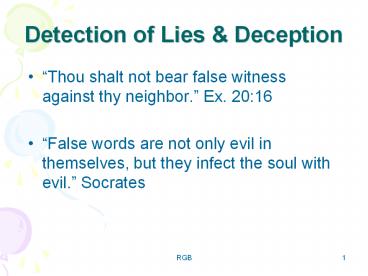Detection of Lies - PowerPoint PPT Presentation
1 / 21
Title:
Detection of Lies
Description:
Lying by commission (fabricating information, active deceit, requires greater ... guilt or excitement (or high emotion) or if the lie is difficult to fabricate ... – PowerPoint PPT presentation
Number of Views:145
Avg rating:3.0/5.0
Title: Detection of Lies
1
Detection of Lies Deception
- Thou shalt not bear false witness against thy
neighbor. Ex. 2016 - False words are not only evil in themselves, but
they infect the soul with evil. Socrates
2
Defining Deception
- Lies do not necessarily represent complete
distortions of reality! - Mitchell (1986) Deception is a false
communication that tends to benefit the
communicator. - Krauss (1981)Deception is an act that is
intended to foster in another person a belief or
understanding with the deceiver considers to be
false.
3
Defining Deception
- Lies do not necessarily represent complete
distortions of reality!
X X ACCIDENT
X X
4
Lying Everyday Social Interaction (DePaulo et
al. 1996)
- People lied almost twice a day, lied to 34 of
all interactions - Told fewer lies to people they felt emotionally
closer - Told 1 lie in every 10 social interactions with
spouses - Only 18 of the lies were detected by others
- 83 would like to get a job (Heywood, 1998)
- 90 wiling to lie to a prospective date
5
History of detection of deception
- Trial by Combat (resolving issues through human
strength) - Trial by Ordeal (based on religious beliefs, i.e.
China, Middle East) - Trial by Torture (witch-hunts inquisition)
- Trial by Jury (fact finders)
6
Concept of Lie Deception
- Both psychological physiological phenomena play
an important role in the truth finding process. - Physiological phenomenon occur as reactions to
stress fear when we are under stress or
serious threats, our autonomic nervous system
will inhibit salivation and all digestive
processes, and result in a dry mouth. - Others blood pressure, eye movement, breathing,
sweating etc. - Freeze, fight or flight?
7
Scientific Advancements
- Scientific Cradle (1890)
- Galvanic Skin Response (GSR) (1897)
- Polygraph instrument (1921)
- Forensic assessment interview
- Thermal images of the face (2002)
- Biometrics
8
Fight or Flight or Freeze Response Mechanism
FIGHT
FLIGHT
FREEZE
9
GSR and Polygraph instrument
10
Why Do People Lie?
- To serve self-interest and self-promotion
- Social lies - to avoid awkward situations or
discussion - Privacy concerns
- Others?
11
Types of Lies
- White lies (social conventions, reduce
interpersonal conflicts, makes life easier
sometimes by lying) - Intentionally harmful and self-serving lies (lie
to evade responsibility/illegal acts, lie to
defame or defraud others) - Lying by commission (fabricating information,
active deceit, requires greater cognitive energy,
i.E. Cant contradict prior information) - Lying by omission (this is a method of choice,
involving less risk, simply concealing
information so consider as passive deceit)
12
Non-verbal Behavior
- Three categories Emblems, Illustrators
Adaptors - Emotions - especially facial Expression
- Six universal facial expressions of emotions
Happiness, Sadness, Surprise, Anger, Fear and
Disgust - Crucial - disjunction between verbal content and
emotional display. - Play with emotions (www.do2learn.com)
13
Gender Differences
- Male Self-oriented lies, to gain personal
advantage (to make a positive impression on
others) - Female Other-oriented lies (to protect others)
- Other reasons?
14
Q Can we always accurately spot liars?
- Manipulators, people who score high in social
skills - Actors (more emotional control, ability to
conceal true feelings) - Sociable People (extravert vs. introverts,
socially anxious people tend to feel more
comfortable telling the truth) - Adaptors (some people have special ways of coping
with their insecurity by adapting themselves to
others)
15
Liars may experience 3 different processes
(DePaulo, 1988)
- 1. The Emotional Approach
- 2. The Content Complexity Approach
- 3. Attempted Control Approach
16
2002 Class Experiment Accuracy in Judging
Deception
17
Guidelines for Detecting Deception (Aldert Vrij
2000)
- Be suspicious
- Probing
- Do not reveal important information
- Be informed (context personalities)
- Ask liars to repeat what they have said before
- Avoid abandon stereo-types
- Compare liars behaviour with their natural
behaviour - baseline.
18
Guidelines for Detection of Deception
- Lies detectable via non-verbal cues if liar
experiences fear, guilt or excitement (or high
emotion) or if the lie is difficult to fabricate - Mismatches between speech content non-verbal
behaviour - Deviation from normal or baseline behaviour
- Judgement of lying only after other explanations
have been negated - Encourage suspect to talk talk
- Stereotyped ideas about cues to deception
(avoidance of eye contact, fidgeting etc.) --
individual differences are crucial
19
Non-verbal behaviours (Vrij 2000)
- Vocal Characteristics
- Speech hesitations
- Speech errors
- Pitch of voice
- Speech rate
- Latency period
- Frequency of pauses
- Pause duration
20
Non-verbal behaviours (Vrij 2000)
- Facial Characteristics
- Gaze
- Smile
- Blinking
- Movements
- Self-manipulations e.g. scratching/rubbing
- Illustrators functional hand arm movements
- Hand finger movement non-functional
- Leg foot movement
- Head movement nods shakes
- Trunk movement or upper body e.g. shrugging
- Shifting position re-arrangements of sitting
position etc.
21
(No Transcript)































